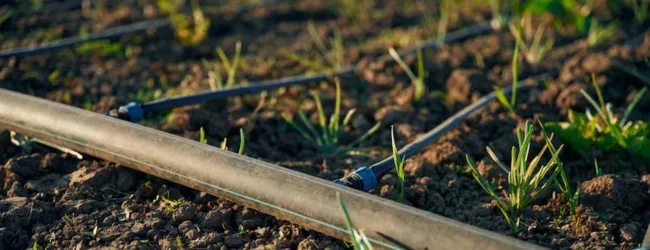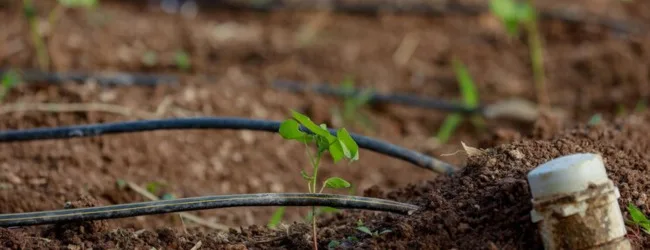Table of contents
- What is Drip Irrigation?
- Where Was Drip Irrigation Invented?
- Why Urban Gardening Needs Drip Irrigation
- Benefits of Drip Irrigation for Urban Growers
- Key Components of a Drip Irrigation System
- Step-by-Step Drip Irrigation Installation Guide
- Drip Irrigation Cost for Small Urban Gardens (India – 2025)
- Maintenance Tips for Long-Term Use
- Real-Life Example: Urban Garden in Bengaluru
- Is Drip Irrigation Worth the Investment?
- Conclusion
- Frequently Asked Questions (FAQs)
Drip irrigation is a smart watering technique that’s transforming urban gardening businesses across India. In simple terms, it delivers water directly to the roots of plants, drop by drop, saving water, time, and money. Whether you’re managing a rooftop vegetable garden or a vertical herb wall, drip irrigation helps ensure healthy plant growth with minimal waste. In a world where water conservation is critical, adopting this method is both eco-friendly and profitable for small-scale urban farmers.
What is Drip Irrigation?

Drip irrigation is a type of micro-irrigation system that delivers water slowly to the base of plants using a network of tubes, valves, and emitters.
✅ Features:
- Water drips directly at the root zone.
- Operates at low pressure.
- Ideal for small, crowded, or rooftop gardens.
- Highly customizable layout.
🧠 Did You Know?
Drip irrigation uses up to 60% less water than traditional methods like hosepipes or sprinklers. (Source: FAO)
Where Was Drip Irrigation Invented?
Drip irrigation, as we know it today, was first developed in Israel in the 1960s.
🔬 Historical Snapshot:
- The modern concept was pioneered by engineer Simcha Blass and his son Yeshayahu Blass.
- In 1965, Simcha partnered with the company Netafim, based in Kibbutz Hatzerim, Israel, to commercialise drip irrigation systems.
- His breakthrough discovery? A tree in his garden grew faster because it received slow, consistent water through a leaking pipe.
- This led to the first practical drip emitter, which revolutionised farming in arid climates.
🌐 Global Impact:
- Since its invention, drip irrigation has spread across over 100 countries, especially in water-scarce regions like India, Australia, the Middle East, and parts of Africa.
- India adopted drip irrigation technology in the 1980s, and it has since been promoted heavily under government schemes like PMKSY (Pradhan Mantri Krishi Sinchayee Yojana).
🧠 Fun Fact: Today, Israel grows over 80% of its food using advanced drip irrigation despite having very limited freshwater resources!
Why Urban Gardening Needs Drip Irrigation

Urban spaces often face challenges like:
- Limited water supply.
- Restricted growing space.
- Inconsistent manual watering.
Drip irrigation is the perfect solution for:
- Rooftop vegetable gardens
- Terrace herb beds
- Balcony flower pots
- Vertical farming setups
- Community gardening projects
Benefits of Drip Irrigation for Urban Growers
| Benefit | Explanation |
|---|---|
| Water Efficiency | Delivers water directly to roots with no runoff. |
| Higher Yields | Healthier roots = healthier, more productive plants. |
| Saves Time | Automate irrigation using timers or smart controllers. |
| Reduces Weeds | Water doesn’t reach unwanted areas. |
| Prevents Soil Erosion | Low-pressure system avoids soil disturbance. |
| Compatible with Fertilizers | You can add nutrients via the system (fertigation). |
| Environmentally Friendly | Cuts down water usage, supports sustainable farming. |
💡 Pro Tip: If you want to start a Business but have too many doubts, connect with a Business expert from Boss Wallah for guidance – Check Out
Key Components of a Drip Irrigation System
| Component | Function |
|---|---|
| Mainline Tubing | Carries water from the source. |
| Emitters/Drippers | Releases water in drops at specific flow rates. |
| Micro Tubing | Connects emitters to the main line. |
| Filters | Removes particles that can clog the system. |
| Pressure Regulators | Controls water pressure to avoid leaks or bursts. |
| Timers/Controllers | Automates the watering schedule for convenience. |
ALSO READ | Organic Manure Production for Small Farms: A Step-by-Step Guide in India
Step-by-Step Drip Irrigation Installation Guide
Tools Required:
- Drip kit (available online or in gardening stores)
- Scissors or a pipe cutter
- Hole punch
- Garden stakes or holders
Installation Steps:
- Plan the Layout
- Sketch your garden area and mark where each plant is.
- Decide where emitters should go.
- Install the Mainline Tubing
- Connect tubing to a water source (tap, tank, or rain barrel).
- Use connectors for turns.
- Attach Emitters
- Punch holes in the tubing.
- Insert emitters close to each plant’s base.
- Add Micro Tubes
- Use for distant plants.
- Anchor them with stakes.
- Install Filters and Pressure Regulators
- Attach between water source to and tubing.
- Test the System
- Turn on the water and check for leaks or uneven flow.
- Automate with Timers
- Set watering time early morning or late evening.
Drip Irrigation Cost for Small Urban Gardens (India – 2025)
| Garden Size | Approx. Cost (INR) | Inclusions |
|---|---|---|
| 100 sq. ft. | ₹1,000 – ₹1,500 | Basic DIY kit with 20–30 emitters |
| 200–300 sq. ft. | ₹2,500 – ₹4,000 | Timer, filters, pressure regulator included |
| Rooftop Setup | ₹5,000 – ₹8,000 | Smart automation, solar-powered timers (optional) |
💡 Note: Government subsidies for micro irrigation may reduce costs by up to 40–70% under schemes like PMKSY (Pradhan Mantri Krishi Sinchayee Yojana).
ALSO READ | What is Agro-Based Industries? Definition, Characteristics & Functions (2025)
Maintenance Tips for Long-Term Use
- Clean filters monthly.
- Check for clogged emitters.
- Replace damaged tubing or connectors.
- Flush the system every 2–3 months.
- Use a water tank with good filtration for optimal performance.
Real-Life Example: Urban Garden in Bengaluru
Sahana Rao, a terrace gardener in Bengaluru, installed a ₹3,000 drip system for her 150 sq. ft garden. Her water usage reduced by 50%, and she saw a 25% increase in vegetable yield in just 3 months.
Is Drip Irrigation Worth the Investment?

Absolutely. It offers:
- Low-cost installation,
- Water savings of up to 60%,
- Reduced effort and maintenance,
- Better yields and healthier plants.
Whether you’re a home grower or a commercial urban farmer, drip irrigation gives the best return on investment, both financially and environmentally.
Need Expert Guidance?
Starting a business can be challenging, but you don’t have to do it alone! At Boss Wallah, our 2,000+ business experts are ready to provide valuable insights and guidance. Whether you need help with marketing, finance, sourcing, or any other area of any business, our business experts are here to help you succeed
Confused about Which Business to Start?
Want to start your own business but unsure which one to choose? Explore Boss Wallah, where you’ll find 500+ courses by successful business owners, featuring practical, step-by-step guides on starting and growing various businesses.
Find your perfect business idea today
Conclusion
Drip irrigation is a game-changer for urban gardening businesses. From water conservation and better yields to automation and cost savings, its benefits are unbeatable. With simple installation steps and affordable kits available in India, even small rooftop farmers can thrive. Make the smart switch today to grow more, waste less, and support a greener future.
Frequently Asked Questions (FAQs)
Drip irrigation delivers water directly to plant roots drop by drop using emitters and tubes, reducing water loss and promoting healthier growth.
Yes, many DIY drip irrigation kits are available online and in local gardening shops, ideal for beginners.
For small gardens, it ranges from ₹1,000 to ₹8,000 depending on area and automation level.
Absolutely! It’s perfect for small spaces, pots, vertical gardens, and terraces.
Usually, 15–30 minutes daily or as per plant needs. Use a timer for convenience.
Clogged emitters, low pressure, and damaged tubing are common but easy to fix.
Yes, it reduces water bills and increases crop yield, making it highly cost-effective
Yes, you can add liquid fertilisers using fertigation techniques.
Yes. It saves water, reduces waste, and minimises weed growth, supporting sustainable gardening.
Yes. Under PMKSY and state schemes, you may get up to 70% subsidy on equipment


